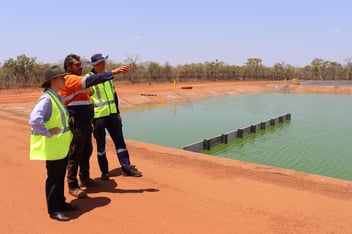Water contamination fears spread beyond Air Force bases
As concerns about PFAS contamination spread around the country, the problem is not confined to drinking water sources and the legacy of firefighting foams, a water utility manager has warned.
The water industry must also consider current sources of PFAS (per- and poly-fluoroalkyl substances) and their impact on wastewater and biosolids, said Hunter Water Manager Environment and Sustainability Angus Seberry.
“It is a potential can of worms in terms of understanding what the actual environmental and or public health risks are, and what regulatory limits are going to be,” he said.
“At the moment there aren't any regulatory limits but that may change in the future.”
Hunter Water has been at the centre of dealing with one of the nation's most prominent PFAS contamination case stemming from legacy firefighting foams containing PFAS used at the RAAF Base Williamtown site.
Since the emergence of the Williamtown case, Defence has launched the National PFAS Investigation and Management Program, which has current investigation sites in Victoria, New South Wales, Queensland, South Australia, Western Australia.
Seberry will discuss Hunter Water's experience in managing the flow-on effects of contamination in a presentation at the upcoming Ozwater’17 conference – PFAS in wastewater - what is all the PFOS about?
For the past year, Hunter Water has been testing for PFAS at priority wastewater treatment plants.
“The treatment plants don't actually have the capability to treat PFAS so it passes through the treatment plant and then partitions partly into the effluent and partly into the biosolids,” Seberry said.
“Hunter Water, along with many other water utilities, has biosolids land application programs so it's an emerging issue to identify whether PFAS chemicals are present within biosolids and where these biosolids are going.”
The testing regime has also uncovered PFAS in trade waste.
“We've now focused on two treatment plants which we think are our areas of most risk and we've been starting up a sampling program where we're testing all our large- and moderate-sized trade waste customers,” Seberry said.
“At one treatment plant, we've instigated a monitoring program in downstream receiving waters and we've been liaising with various government agencies about test results. We've also undertaken consultation with downstream water users advising them about precautions they need to take in relation to the treated water discharge.”
PFAS are not only found in defence and civilian firefighting foams, they're also in hundreds of household products (for example non-stick cookware and stain-proof carpets, furnishings and fabrics) and are therefore commonly found in landfill and manufacturing.
“We're still learning which areas are of most concern but anywhere there's oil refining, chemical manufacture, waste disposal, vehicle maintenance, engineering manufacturing – all of those customers are ones we're finding probably need a closer look,” Seberry said.
His advice for other water utilities was to start monitoring for PFAS levels before the interim national guidance on human health reference values was replaced with regulation.
“It would be good from a risk perspective to have some awareness of which of your wastewater catchments are more vulnerable to getting levels of PFAS and hence maybe targeting sampling at some of your plants,” he said.
“It's always good to have a bit of a handle on what your background levels are before the regulation comes in so you can be on the front foot.”
Hear more from Angus Seberry:
https://omny.fm/shows/australianwater/angus-seberry-on-pfas-in-wastewater


